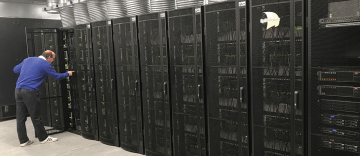Sandeep Ravindran in The Scientist:
 If scientists want to simulate a brain that can match human intelligence, let alone eclipse it, they may have to start with better building blocks—computer chips inspired by our brains. So-called neuromorphic chips replicate the architecture of the brain—that is, they talk to each other using “neuronal spikes” akin to a neuron’s action potential. This spiking behavior allows the chips to consume very little power and remain power-efficient even when tiled together into very large-scale systems. “The biggest advantage in my mind is scalability,” says Chris Eliasmith, a theoretical neuroscientist at the University of Waterloo in Ontario. In his book How to Build a Brain, Eliasmith describes a large-scale model of the functioning brain that he created and named Spaun.1 When Eliasmith ran Spaun’s initial version, with 2.5 million “neurons,” it ran 20 times slower than biological neurons even when the model was run on the best conventional chips. “Every time we add a couple of million neurons, it gets that much slower,” he says. When Eliasmith ran some of his simulations on digital neuromorphic hardware, he found that they were not only much faster but also about 50 times more power-efficient. Even better, the neuromorphic platform became more efficient as Eliasmith simulated more neurons. That’s one of the ways in which neuromorphic chips aim to replicate nature, where brains seem to increase in power and efficiency as they scale up from, say, 300 neurons in a worm brain to the 85 billion or so of the human brain.
If scientists want to simulate a brain that can match human intelligence, let alone eclipse it, they may have to start with better building blocks—computer chips inspired by our brains. So-called neuromorphic chips replicate the architecture of the brain—that is, they talk to each other using “neuronal spikes” akin to a neuron’s action potential. This spiking behavior allows the chips to consume very little power and remain power-efficient even when tiled together into very large-scale systems. “The biggest advantage in my mind is scalability,” says Chris Eliasmith, a theoretical neuroscientist at the University of Waterloo in Ontario. In his book How to Build a Brain, Eliasmith describes a large-scale model of the functioning brain that he created and named Spaun.1 When Eliasmith ran Spaun’s initial version, with 2.5 million “neurons,” it ran 20 times slower than biological neurons even when the model was run on the best conventional chips. “Every time we add a couple of million neurons, it gets that much slower,” he says. When Eliasmith ran some of his simulations on digital neuromorphic hardware, he found that they were not only much faster but also about 50 times more power-efficient. Even better, the neuromorphic platform became more efficient as Eliasmith simulated more neurons. That’s one of the ways in which neuromorphic chips aim to replicate nature, where brains seem to increase in power and efficiency as they scale up from, say, 300 neurons in a worm brain to the 85 billion or so of the human brain.
Neuromorphic chips’ ability to perform complex computational tasks while consuming very little power has caught the attention of the tech industry. The potential commercial applications of neuromorphic chips include power-efficient supercomputers, low-power sensors, and self-learning robots. But biologists have a different application in mind: building a fully functioning replica of the human brain.
…It’s still early days, and truly unlocking the potential of neuromorphic chips will take the combined efforts of theoretical, experimental, and computational neuroscientists, as well as computer scientists and engineers. But the end goal is a grand one—nothing less than figuring out how the components of the brain work together to create thoughts, feelings, and even consciousness.
More here.
